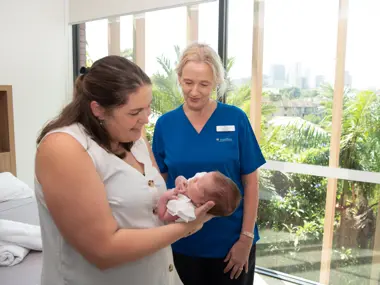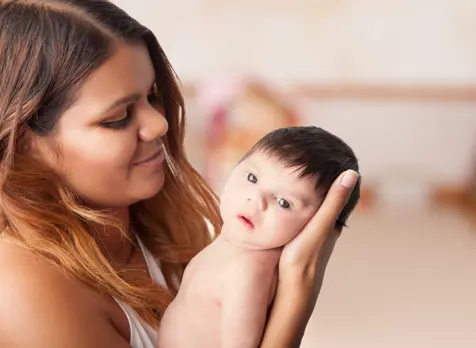Newborn Play
Time spent playing with and talking to your baby is important for their development. Learn Tresillian’s tips on the best ways to play with your newborn.

You might be wondering how you're meant to play with your newborn who seems to eat and sleep most of the time. However taking time to play, even just moments here or there, is important, and can be a wonderful way to get to know and build your relationship with your baby.
How do you know your baby is ready to play?
Your newborn's play window may be brief and fleeting during the first few weeks of their life. Some cues your baby might display when they're ready to play include smiles, alert and bright eyes, gazing at you and reaching out.
These moments of play are where you convey your sense of joy and delight in your baby.
How to play with a newborn in the first few weeks
-
1
Talking and singing to them: Your baby will love listening to you so try to talk and sing to them as much as possible. Call your baby by their name, count their toes and fingers and read to them. You can talk during feeding, dressing and bathing, describing to them what you are doing. Pause and smile at your baby when they ‘talk’ to you.
-
2
Reaching towards you: Lay your baby on a pillow on your lap, and play “open shut them” hand and singing games with them. Stretch out their arms and legs and describe what you are doing.
-
3
Playing imitation games: While looking at your baby, try opening and closing your mouth like a fish. You’ll notice your baby watches your mouth intently, and in time, will try and copy what you are doing.
-
4
Looking at objects: Show your baby things, such as a mobile with strong contrasting features and colours. Talk about what they look like, how they move and what they do.
-
5
Playing with rattles: Give your baby soft textured rattles that they can hold and feel easily, or plastic rattles they can mouth safety and be wiped clean. Importantly, rattles must not have any loose or sharp parts.
-
6
Feeling textures: These include textures of the different fabrics on toys – smooth satin and rough towelling, for example. Your baby will probably also enjoy the sensation of being bathed and held safely in warm water, which can feel soothing and pleasant.
-
7
Enjoying music together: Choose gentle music that doesn’t make your baby startle. Sing and dance with your baby if you enjoy it too.
Newborn tummy time
Tummy time can begin safely from birth. It's an important way to help strengthen your baby's neck muscles and protect the shape of their head. You can do it regularly throughout the day.
Start with one or two minutes at a time and build it up slowly. Australian guidelines recommend at least 30 minutes of tummy time over the course of the day.
Initially, you could start by laying your baby on your chest while lying down (remember not to fall asleep). You can place a rolled towel under their chest to help.
As they get more used to it, you could place them on their tummy on the floor. Talk to them to reassure them, particularly if it's their first few times trying it. Always stay with your baby while they're doing tummy time.
Other newborn play ideas
-
1
Hang a colourful mobile: Your baby will enjoy looking at a bright object while they're doing floor time or during a nappy change.
-
2
Play mat: Use a play mat with hanging toys. Your baby can reach for the toys and try to swat at them which helps with their hand-eye coordination.
-
3
Mirror Play: Babies are fascinated by their own reflection. Place a baby-safe mirror in front of your baby or lay them in front of a mirrored door wardrobe and let them explore their own face and the reflections.
-
4
Peek-a-Boo: Play peek-a-boo by covering your face with a cloth or your hands and then revealing your face with a cheerful "peek-a-boo!"
-
5
Nature Walks: If the weather is suitable, take your baby for a short walk outside. They can experience different sights, sounds, and smells, which can be stimulating for their senses.
-
6
Reading: Even though they may not understand the words yet, reading aloud to your baby introduces them to language, rhythm, and the comforting sound of your voice.
-
7
High-Contrast Toys: Newborns have limited vision, so black and white toys or images with high-contrast patterns can captivate their attention. You can find books, mobiles, or cards designed with these patterns.
When to finish playing with your newborn
Always stay near your newborn during their play time, both for safety and to keep an eye out for cues that they've had enough. Some signs that your baby needs a break or change in activity include frowning, back arching, turning away from you or their toys, making a sad face or crying.











































